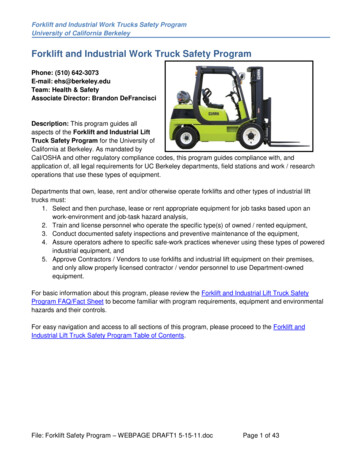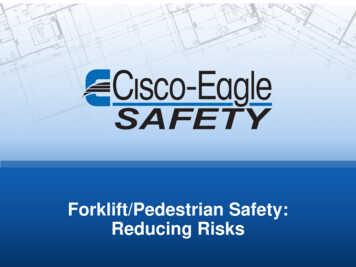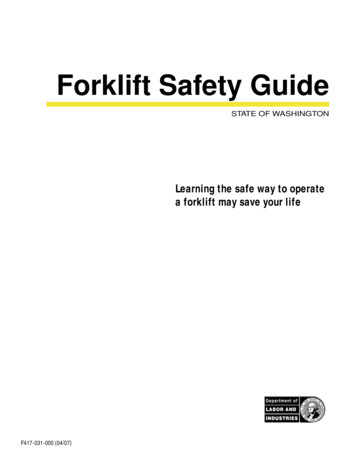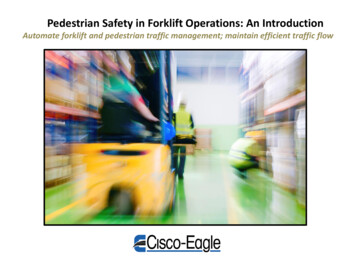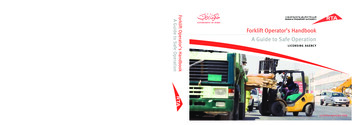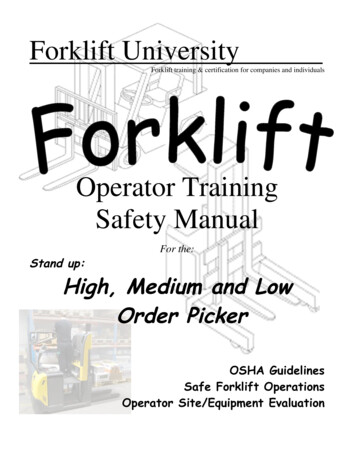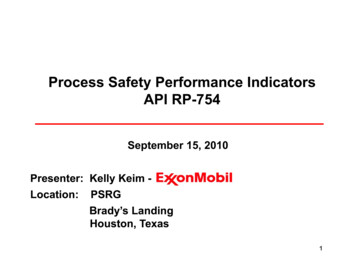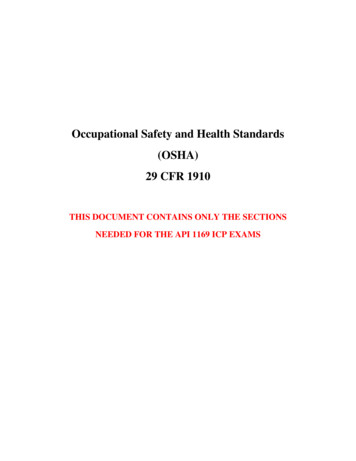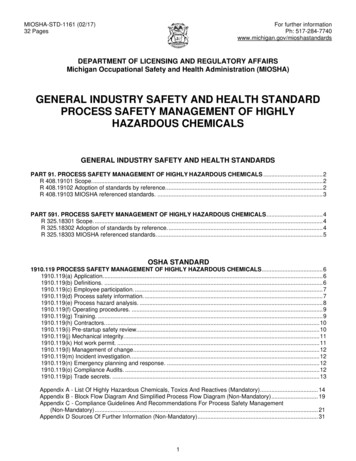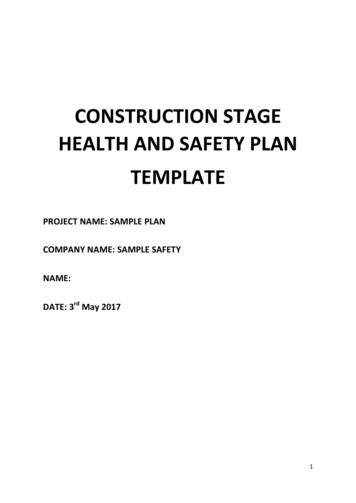
Transcription
FORKLIFT SAFETY TIPSInformation SheetDecember, 2013Forklifts are extremely useful workplace vehicles, as long as they are used safely and appropriatelyby operators who are appropriately trained and competent to use them.Forklifts can be dangerous: they account for 25% of injuries at work. Many workplace accidentsinvolve people being hit or run over by forklift trucks (typically when the forklift is reversing)because the driver did not see them. Owing to their size and weight, injuries resulting from forkliftsare generally very serious. Accidents involving them are often caused by poor supervision and alack of training.The following forklift safety tips will help you and those you work with stay safe around forklifts.What is a forklift?What the law requiresA forklift is a powered truck used to carry, lift, stack ortier materials. They include pallet trucks, rideroperated forklifts, fork trucks, or lift trucks.If you own, lease, hire or borrow a vehicle for workpurposes, you must make sure that it is safe for use andfit for the purpose for which it is intended.They can be powered by electric battery orcombustion engines.Under health and safety legislation, a vehicle is a placeof work. The law requires that workplaces aremaintained in a condition that is safe and without riskto safety and health. Vehicles must be kept safe and fitfor purpose and the driver must be able to get in andout of the vehicle safely.Forklifts are subject to statutory examination by acompetent person once every 12 months inaccordance with S.I. 299 of 2007 (Safety, Health andWelfare at Work (General Application) Regulations2007).This period becomes 6 months if the forklift isused to lift persons.Forklifts also are classed as work equipment.Employers must make sure that drivers are familiar withthe vehicle they are driving and that they have beengiven appropriate instruction, information andtraining to carry out required prechecks and to use the vehiclein the correct and safemanner, as per themanufacturer’s instructions.Page 1 of 6
FORKLIFT SAFETY TIPSInformation SheetEmployers must also make sure that they have adefect reporting system in place so that when defectsare found that they are rectified. Employees shouldnever be required to operate under conditions thatare unsafe or that do not comply with the law.Employers must make sure that forklifts are providedin a safe condition for use at work. This can beachieved by having a preventative maintenancesystem which includes scheduled checks as per themanufacturer’s instructions.Employees have legal duties to use work equipmentin a safe manner in line with procedures developed bytheir employer. Slow down at corners, doorways, and atdanger spots Sound the horn several times when approachingblind corners, exits and entrances Switch off and remove the key before leaving theforklift. Place the key in a safe location whendriving task is completed Apply the parking brake before leaving the forklift Face the forklift and use the steps and handholdswhen getting in or out of the vehicle. Use threepoints of contact Report any accidents or near misses to a supervisorSafe OperationNever:Always: Operate a forklift unless you are trained, competentand authorised to do so Wear appropriate personal protective clothingas provided by employer. Hard hat, protectivefootwear and high visibility clothing arerecommended as a minimum when working aroundforklifts. Other equipment may be neededdepending on the working environment Use a forklift or equipment you know is notworking properly Operate controls from outside the cab, unless it isdesigned so you can do this Carry out a pre-shift check of the forklift Stand on or near the controls to reach the load oranything outside the cab Report defects immediately to supervisor Start or stop suddenly Make sure work path is free of obstructions Make abrupt or quick turns Wear operator restraints, where fitted travel on uneven ground unless the forklift issuitable for this Look all around before moving off Run over unprotected cables or flexible pipes Look in the direction of travel Travel at a speed suitable for the location and theload carried Travel with the forks lowered, but clear of theground Watch out for pedestrians Avoid sudden stops and violent braking Take care when driving on wet, icy , slippery orloose surfaces Try to carry out repairs – leave this to a qualifiedmaintenance engineer Operate a forklift when under the influence ofalcohol or drugs [prescribed or illegal] Use mobile phones or other hand-held deviceswhile operating the forklift Use uncertified attachments Use an attachment unless a competent person, anauthorised dealer, or manufacturer has derated theforklift [reduced actual capacity]Page 2 of 6
FORKLIFT SAFETY TIPSInformation SheetCarrying LoadsNever:Always: Lift loads greater than the capacity of the forklift Assess the load before lifting. Check weight, size,load centre and security Move a load that appears unsuitable or unstable(including on a damaged pallet) Make sure that pallets are in good condition Lift load with attachments, unless trained, certifiedand authorised to do so Observe floor loading limits Find out the weight of the laden forklift Check safe working load (SWL) of racking beforeplacing loads onto it Make sure load does not obstruct view. If it does,drive in reverse, looking in direction of travel Make sure there is adequate clearance for theforklift and load, including overhead Make sure the load does not exceed capacity offorklift Make sure the load is stable and can be safely lifted Travel with a bulky load that blocks your view Carry the load as close to ground as possible Use controls smoothly Travel with a raised load, unless the forklift isdesigned specifically for this Position forks properly and as widely as possible Leave the vehicle with the load raised. Make sure the fork arms are fully inserted whentravelling with a load Make sure the forklift is stopped before raising theload Use suitable attachments for lifting unusual or wideloads Lower loads at a safe speed Make sure you are properly trained, certified andauthorised to operate the forklift with anattachmentOperating on SlopesAlways: Travel slowly when going down slopes Ensure the forks face uphill when travelling up ordown slopes with a load Ensure the forks face downhill when travelling upor down slopes without a load Adjust the tilt (where fitted) to suit the gradient andraise the forks to clear the groundPage 3 of 6
FORKLIFT SAFETY TIPSInformation SheetNever:When you have finished working Turn the vehicle around on or travel across a rampor a slopeAlways: Leave a forklift on a slope, except in anemergency. In case of emergency always chockthe wheels Park the forklift in a safe place, on level ground;never on a slope Leave the forklift with the mast tilted forwards andthe forks fully lowered, with the tips on the floor Apply the parking brake, select neutral, switch offthe engine and remove the keyCarrying PeopleAlways: Use a safe work method when using workingplatforms, i.e integrated platform. Use of nonintegrated platforms should only be permissible inexceptional circumstances under documentedcontrols Remain in control of the forklift while workers areon the platform Return keys or other activating devices to theirplace of safe-keeping Report any malfunctions or defects immediately toa supervisorWhere can I find further information?Further information and guidance on forklifts can befound in the HSA's 'Code of Practice for RiderOperated Forklifts: Operator Training andSupplementary Guidance'. Watch out for pedestrians Use spotters when operating in congested areasForklift operator pre-use checks sheets are availableat www.vehiclesatwork.ie or by contactingLoCall: 1890 289 389 (between 9am and 5pm,Monday to Friday) - Additional resources: HSEGuidance Working Platforms (Non-integrated) onForklifts - Guidance Note PM28Never: Lift a person on the forks or on a pallet, or similar,balanced on the forks Move travel or turn with a person lifted at height Carry passengers, unless the forklift is designedfor this and has a designated seat and seat belt Allow people to walk under raised forks or loads Leave a truck unattended when people are using anon-integrated platform Pick up a load if someone is standing closeto itPage 4 of 6
Page 5 of 6 No evidence of leaks. No obstructions (overhead or in workingarea). Correct forklift type for workingenvironment.Working Environment Forklift truck registered andnumber plate (front and rear)displayed, clean and legible. Valid tax and insurance discdisplayed. Road lights (side, head, rear, stopand number plate lights) in place,clean, correct colour and workingcorrectly.If used on the Public RoadNote: Head, stop and directionindicator lights are not required ifthe truck cannot exceed 12 milesper hour (19 Kilometres per hour)provided that the driver is clearlyvisible on all sides, can give handsignals to other traffic and thevehicle is not used during lightingup hours except in an adequatelylit public place. Thorough examination carriedout every 12 months (every 6months if used to lift persons)by a competent person andtest certificate available.Thorough Examination General Condition. Forks. Carriage Plate. Mast. Back Rest Extension / Load Guard. Lift Chains. Tyres. Wheels. Overhead Guard / Roll OverProtection Frame. Energy Source. Hydraulics. Identification / Rating Plate. Operator’s Compartment. Access. Lights, Windscreen and Mirrors (if fitted). Fire Extinguisher (if fitted).Seat.Safety Belt.Ignition and Electrical Systems.Reversing Alarm and Horn.Warning Lights and Lights (iffitted).Hydraulic Controls.Brakes (Foot & Parking).Clutch and Gearshift.Steering.Exhaust.Noise.Practical / Operational Checkswww.hsa.ieVisual ChecksForklift Truck Operator Pre-Use Checks
Forklift Truck OperatorPre-Use Checkswww.hsa.ieVehicle Serial / Identification Number OK DEFECTVisual Checks1 General: Good condition with no damage, excessive dirt or rust. Any defects previously noted repaired.2 Forks: Correctly positioned, not damaged, cracked, bent or worn. Anchor pins secure and not worn, loose or bent.3 Carriage Plate: No damage or distortion, sitting square to the mast and lubricated. End stop bolts engaged and secure.4 Mast: No damage, distortion or cracks. No undue wear, scoring, dirt or foreign bodies in channels. End stops secure. Rollers, no unevenwear or incorrect tracking. Slides intact and secure.5 Back Rest Extension / Load Guard: In good condition, secure with no distortion or cracks.6 Lift Chains: Not damaged worn or stretched, no broken links or rust. All pins in place.7 Tyres: No damage, excessive dirt or wear, rust, cracks, splits or separation of tyres and rims. Pneumatic tyres correct air pressure.8 Wheels: Undamaged and free from obstruction and debris. All nuts secure and in place.9 Overhead Guard / Roll Over Protection Frame: Secure, undamaged with no loose items.10 Energy Source: Gas or Diesel: Engine oil, fuel and radiator water level correct. Gas bottle secured, no rust, corrosion or damaged pipes, hoses or seals. Electric: Electrolyte level, battery plug and connections correct. Power cable intact, connected and secure. No exposed wires, batterybrackets secure and battery adequately charged.11 Hydraulics: No damage or fluid leaks, no splits in hoses, no leaks around fittings.Check Items12 Identification / Rating Plate: Intact, clean and legible.13 Operator’s Compartment: Clean with no loose items.14 Access: Steps and grab handles in good condition and clean.15 Lights, Windscreen and Mirrors (if fitted): Clean and undamaged.16 Fire Extinguisher (if fitted): Secure and charged.Operational Checks17 Seat: Good condition, secure and adjusted correctly.18 Safety Belt: Accessible, in good condition and working correctly.19 Ignition & Electrical System: Working correctly. All gauges and instruments visible and working.20 Reversing Alarm and Horn: Working correctly and audible.21 Warning Lights & Lights (if fitted): Working correctly.22 Hydraulic Controls: Working smoothly and correctly.23 Brakes (Foot & Parking): Working correctly.24 Clutch & Gearshift: Working smoothly and correctly.25 Steering: Working correctly with no excessive play.26 Exhaust: No excessive smoke, sparks or flames.Defect DetailsOperator’s SignatureDateManager’s / Supervisor’s SignatureDateNote: This is a sample operator pre-use forklift truck checklist. It is recommended that employers prepare their own operator pre-use checklists, taking account of the manufacturer’srecommendations, the type and use of their own forklift trucks.Page 6 of 6
FORKLIFT SAFETY TIPS Information Sheet Carrying Loads Always: Assess the load before lifting. Check weight, size, load centre and security Make sure that pallets are
